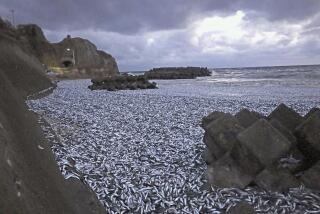Return of Humpbacks Pulls in Tourists
- Share via
ZAMAMI VILLAGE, Japan — After avoiding the azure waters of this tropical islet for decades, the whales of Zamami are back. But this time, tourist boats, not harpoons, are greeting them.
Zamami, about 1,000 miles southwest of Tokyo, is one of several remote areas in Japan that have launched whale-watching programs to capitalize on the average citizen’s increasing sympathy toward whales.
Zamami’s whaling industry died out in the 1960s, when the whales stopped swimming into the region on their annual spring mating journeys south. Six years ago, however, they began returning, unharmed.
“The fact that people come here to watch, not whale, shows how times have changed,” said Akira Oshiro of Zamami’s village office.
According to a recent poll by Britain’s Whale and Dolphin Protection Conservation Society, most Japanese believe whales should be protected as endangered species. An overwhelming majority said there is no need to eat whale meat.
Japan, however, continues to be the world’s largest whale meat consumer, and the government is one of the staunchest advocates of whaling, which was banned for five years commercially beginning in 1986.
Along with Iceland and Norway, it fought for a permissive resumption of commercial whaling at the International Whaling Commission’s annual meeting in May in Iceland.
The proposal was defeated, and instead, the commission voted to preserve a cautious management plan that may lead to only limited commercial hunting.
In any case, Japan is likely to continue the limited whaling it is allowed for research purposes. All of that meat is sold, mostly to specialty restaurants that carry on the now-declining Japanese tradition of eating whale meat.
“The only people who need whale meat these days are gourmets,” said Hideyasu Miyahira, owner of the Zamami Diving Center and a whale-watching guide. “That’s not a good reason for us to whale again.”
During their heyday in 1958, whalers in this region took 290 whales from waters around Zamami and other islands in Okinawa, Japan’s southernmost prefecture. By 1964, no whales were caught.
“So many whales were taken that there just weren’t any more left,” Oshiro said. “The whales stopped coming here because they were harpooned before they could finish the trip.” This year, however, Zamami officials counted about 40 returning whales.
Zamami’s 800 residents depend mainly on divers and tourists for their income. At the village’s only dock, where all tourists arrive, a red-lettered billboard makes the islanders’ message clear: “Protect our natural resources.”
About 300 whale watchers arrived on Zamami’s beaches this season for a glimpse of the giant mammals, that come from Alaska each spring.
“When the first whale returned here six years ago, the whole island was overjoyed,” Oshiro said. “We all thought it was a freak, but every year they keep coming back, more and more of them each time.”
And to help protect Zamami’s whales--which are mostly humpbacks, the village office established a Whale Watching Assn. in March, and is drawing up whale-watching regulations.
“When you’ve seen one, your feelings about them change,” said Miyahira. “They come up so close you can smell their breath. It’s quite a thrill.”
More to Read
Sign up for Essential California
The most important California stories and recommendations in your inbox every morning.
You may occasionally receive promotional content from the Los Angeles Times.













